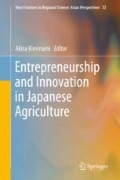Abstract
We studied some cases of HRD programs related to fostering entrepreneurs for the rural innovation in Japan with the consideration of lessons from the experience of LEADER in the EU. Compared to the case of the EU, the role of local governments is rather substantial in Japan. Therefore, the endogenous development model of LEADER cannot directly apply, and the targeted human resources to foster may be different. However, the fiscal situation of local public entities has been becoming tighter than before in Japan, and the shrinkage of their roles may not be avoidable. Therefore, the organizational innovation of the whole region has become more desired. Savor Japan is a new project introduced in 2017. It certifies the areas trying to attract foreign tourists by utilizing the value of local foods and local primary industry. The destination management/marketing organization (DMO) is established in the certified area as the core organization of the project implementation, and it is organized by various area-oriented businesses. This execution style is partly similar to LEADER, in which a LAG is the center of project activities. Several vocational training courses related to agriculture have been offering capacity-building curriculums for regional leaders because the participants of those courses grow and come to need more advanced information. Consecutive vocational education for farm business executives and the local public entity staff responsible for the planning and management of a rural development project is considered useful because they may form the core human resources for the regional development.
Access this chapter
Tax calculation will be finalised at checkout
Purchases are for personal use only
Notes
- 1.
LEADER stands for liaison entre actions de développement de l’économie rurale.
- 2.
This chapter is mostly based on a study done in PRIMAFF. The findings are partly available in PRIMAFF (2014).
- 3.
This section is based on Tabata (2014).
- 4.
This section is based on Koshiba (2014).
- 5.
As to the 6th industrialization policy of Japan, refer to KREI, PRIMAFF, and IAED (2014).
- 6.
“The abridgment of the third-party evaluation report on the social effects of the community employment creation program by Groundwork Mishima” http://www.gwmishima.jp/modules/information/index.php?lid=623&cid=56
References
Iida, K. (2014). Reality of LEADER program and regional management: A case study of Hessen state, Germany. PRIMAFF, 2014, 17–42. (in Japanese).
Iwasaki, Y. (2016). Trend of departments of community study in national universities after the reform of national universities. Kansai Daigaku Koto Kyoiku Kenkyu, 7, 135–141. (in Japanese).
Koshiba, Y. (2014). Human resources development programs for rural development by universities in Japan. PRIMAFF, 2014, 147–164. (in Japanese).
KREI, PRIMAFF, & IAED. (2014). The 6th industrialization of agriculture. The 10th FANEA Joint Research Report.
Nanseki, T., Iiguni, Y., & Tsuchida, S. (2014). Agricultural innovation and human resources development: International comparison and implications to Japanese agriculture in the next generation. Norin Tokei Shuppan. (in Japanese)
Nishi, K., Tsuchida, S., & Nanseki, T. (2014). Current situation and issues of the system of agricultural human resources development—Focusing on programs of agricultural colleges, university faculties of agriculture and enterprises. Nanseki, Iiguni and Tsuchida, 2014, 247–265. (in Japanese).
OECD. (2006). The new rural paradigm: Policies and governance. Paris: OECD.
PRIMAFF. (2014). Development of personnel and organizations for rural innovation: Movements in Japan and overseas. PRIMAFF Project Research Paper (in Japanese). http://www.maff.go.jp/primaff/kanko/project/26rokujika1.html
Tabata, A. (2014). Human Resources Development Programs for Rural Development by Ministries of Japan: Use of External Human Resources, Fostering of Local Human Resources and Formation of Bases. PRIMAFF, 2014, 129–146. (in Japanese).
Author information
Authors and Affiliations
Corresponding author
Editor information
Editors and Affiliations
Rights and permissions
Copyright information
© 2019 Springer Nature Singapore Pte Ltd.
About this chapter
Cite this chapter
Inoue, S., Koshiba, Y. (2019). Human Resources Development for Agriculture in Japan from the Perspective of European Experience. In: Kiminami, A. (eds) Entrepreneurship and Innovation in Japanese Agriculture. New Frontiers in Regional Science: Asian Perspectives, vol 32. Springer, Singapore. https://doi.org/10.1007/978-981-13-8055-6_5
Download citation
DOI: https://doi.org/10.1007/978-981-13-8055-6_5
Published:
Publisher Name: Springer, Singapore
Print ISBN: 978-981-13-8054-9
Online ISBN: 978-981-13-8055-6
eBook Packages: Economics and FinanceEconomics and Finance (R0)

